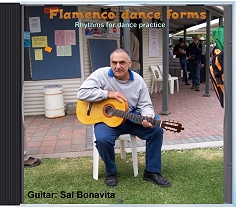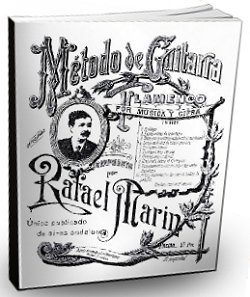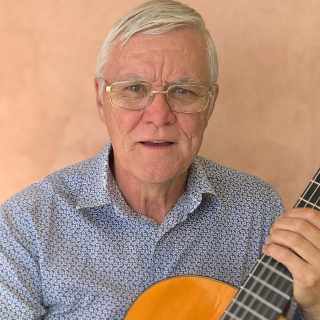
Playing for dancersMy personal experience A dancer calls the shots, not the guitarist. A choreography is never a static or academic thing, but develops as a "work in progress" until both parties are happy with it.
A guitarist's job is basically to mimic the dynamics of the steps with rhythm passages and enhance and embellish the emotion conveyed by the body movements and the overall flavor of the dance form. Having an understanding of the emotional nature of the dance form is also important. This can only be gained by a one-on-one interaction with the dancer. Watching the facial expressions for example, will help to determine what style of falseta you would play.
Although most dance forms follow a basic structure with common elements, these elements are mixed and matched according to the whim of the dancer. Some bits are left out while others are added or extended. Sometimes this happens during the performance itself and the guitarist follows these whims by watching out for visual cues. The only dance I can think of that a guitarist can learn without input from a dancer is Sevillanas. This dance has a solid traditional structure that never varies..ever...no matter how experienced the guitarist or dancer is. A dancer will always be able to put on any CD with Sevillanas and dance to it. Just about everything else depends on the personal choreography of the dancer, or whatever a student learned in class. I have played for many teachers who each had their own unique style of teaching and dancing. Naturally they would pass their style on to their students. Students from one dance school who migrate to another school (this happens a lot) need to modify how they execute their step sequences to suit the new teacher and new guitarist styles.
In some cases, I found myself instructing the dancers on the compás and even the structure of some dances. I can state categorically that it was the dancers themselves who taught me how to accompany flamenco dance. I can't see how I could have done it without them. The actual chords and rhythm styles I learned came from all the music samples they copied for me from CDs. They knew what they wanted. My job, as a guitarist, was to develop the music as best I could from what I could learn from bits and pieces from books, CDs and other guitarists. The end result was always a composition made up of bits and pieces and developed on the fly, and dictated and modified according to my technical limitations. In the beginning, it's all about playing basic compás in the form of rhythm passages only.
When it comes to the actual sound coming out of your guitar, the test of a good accompanist is whether he can play a recognizable dance accompaniment with the strings muffled and using only rasgueado rhythms with traditional accents. More complex accent patterns and variations come later. In essence, a dancer prefers not to hear melodic passages while they dance. Things like tremolo, harmonics and dynamic variations in speed are a no-no in dance accompaniment. A guitarist acts also as a metronome. What is important is accenting the compás. If they don't hear the compás (accented beats in the cycle), they can and do get totally lost. Or rather a dance student tends to get lost. An experienced dancer will just get pissed off and give you dirty looks. The stops and starts in the rhythm must exactly match the steps, otherwise the whole point of accompaniment is lost. The only variations in speed are either dictated by the dancer or the nature of the dance form itself. An example of this is Zapateado and escobilla passages in Alegrias or Solea, where speed variations are expected. But once again, the guitarists need to keep an eye on the dancer because the rate of speed change is dictated by the dancer not the guitarist.
When I first started playing for dances, we did the inevitable charity performances at Spanish festivals, Spanish clubs and Spanish restaurants. Of course, Spanish people who come to listen to flamenco at these types of events (aficionados) usually want to join in and supply the palmas. They know instinctively when a passage is about to end because they know where the compás accents are in the cycle, and when to change the clapping style in the right places (soft and hard palmas). I knew I was no longer a gringo pretending to play flamenco when I felt comfortable playing for Spanish audiences. There is no way I could have reached that point without the personal input from, and interactions with dancers.
I have met many guitarists who played what they thought was flamenco (on their own) but completely ignored the compás and introduced dynamic and speed variations in totally inappropriate places. When they proudly played their book "pieces" for dancers for the first time, they were met with blank looks. Pretty melodies and classical guitar style inflections and tone color have no place when playing for dancers. The best you could say about their music is it may have a vague Spanish flavor to it. It certainly wasn't flamenco. One classical guitarist friend of mine was only interested in learning what he called "flamencoy" sounds, such as typical chords and rasgueados. He was more interested in introducing these sounds into his classical compositions than to make any serious effort to learn flamenco. Fair enough. At least he was honest. He knew it wasn't playing flamenco.
The traditional process to learn how to successfully accompany dancers:
Most "serious" dancers prefer to play a part in it's development. An exeption to this traditional thinking is one dancer I worked with away from the dance studio, who had a background in modern jazz style dance. She liked to freely improvise flamenco steps without any regard to specific compás. That was fine by me. We both knew the "rules" but for a bit of fun, we sometimes made a conscious decision to disregard them. In other words, I could play any style of music (classical, ragtime or whatever) and she was happy to dance to it. That was kind of liberating but we both knew it wasn't flamenco. We just enjoyed what we did.
Here are some other bits worth reading
The following snippits are from Flamenco FAQ for Classical Guitarists
The three rules of accompaniment: 1) Stay in compás. 2) Stay in compás. 3) Stay in compás. How do I learn to accompany? .....it can't be done by ordering a book or CD. You've got to go find some flamencos.
1. Find another guitarist who accompanies and take lessons, or watch, listen, spy, whatever.
2. Start building a collection of recordings (including videos if you can get them), and listen, listen, listen. If you're just starting, the older anthologies are usually better for picking out basic ideas. Contemporary flamenco is pretty jazzy, and while the bones are there, they can be pretty obscure. It helps to go shopping with a knowledgeable flamenco to find the nuggets (if any) at your local stores. Obviously solo guitar recordings aren't going to be too helpful. Neither are the Gypsy Kings for anything but rumbas. Camaron and Paco are great models, but pretty hi-tech.
Student dancers rarely have the chance to work on their own with guitarists, so they're often eager to find ANYONE who plays. It can really help to pair up with a compatible "buddy" and pool resources. One way around the "blind leading blind" syndrome is for you and your buddy (student singer/dancer) to arrange for a private session for both of you with *both* pros just before or after a rehearsal, when they'd both be there anyway. Probably worth it, even if expensive. The flamencos I'm talking about will at least know you're serious if you propose such a thing, and unless they're on ego trips, may well do their best to accommodate you. Some guitar teachers accompany the classes of the dancers with whom they work (or their students do), and of these some will allow or encourage you to sit in. Invaluable. ....you're not a flamenco guitarist by flamenco standards if you can't accompany singers and dancers.
Compás is Spanish for 1) rhythm, generally, 2) measure -- a coherent unit of rhythm, 3) the characteristic rhythm of a particular form. Thus, "he has good compás" means he has a good sense of rhythm. "The introduction is 4 compás long" means something like (but not exactly) "it's four measures long." "I play this in the compás of tientos" means I play it with the same rhythm you'd hear in tientos.
For accompaniment, compás is King. The following quotes are from DCFlamenco Article
"So you want to play for dance classes?" "If a beginner guitarist would like to learn to accompany, it's fine to start with a beginner level dance class." "Don't try a midlevel or advanced class unless there is a professional level guitarist playing, and then be content to play '2nd fiddle' and take his/her advice." "Be prepared to play rhythm and chords. Dance classes don't need fancy falsetas, and in fact these can be more of a hindrance than a help. Besides - the guitarist will learn a lot by playing rhythm and watching and listening to the dancers for each tempo change. Falsetas come later." "I don't think of a guitarist as a Flamenco Guitarist unless they can accompany (in my humble opinion). What defines flamenco is the connection of the artists to the compás, as I have said before; flamenco is an individual artform, but it is a group experience. And sitting in class playing for dancers is the only way to learn, first sitting next to a more experienced player and then by yourself."
|
|

Download my CD
Flamenco Dance Forms

Flamenco guitar method 1902


